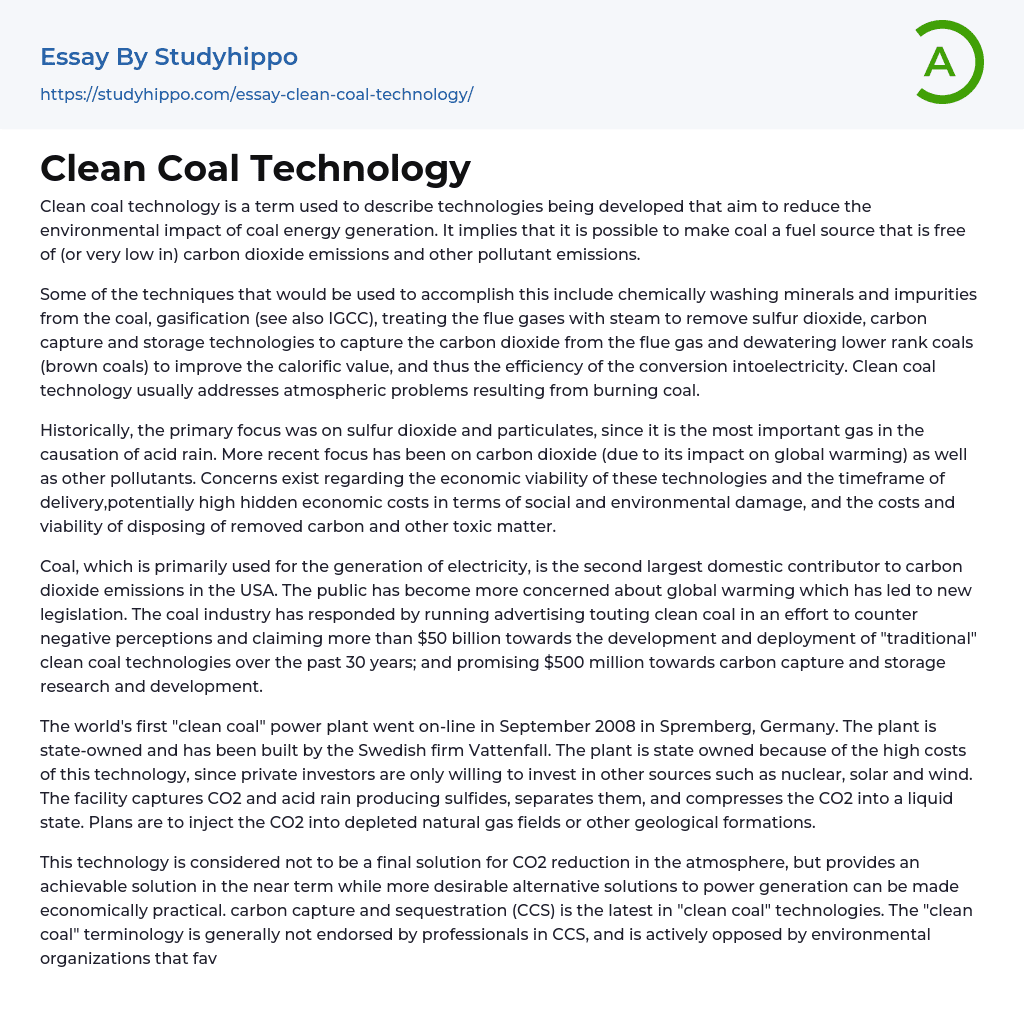'Clean coal technology' is a term that denotes the evolution of techniques aimed at reducing the environmental impact associated with producing energy from coal. This terminology implies that coal could potentially be a fuel source emitting negligible or no carbon dioxide and other harmful substances.
There are several techniques that can be utilized to reach this goal. Such techniques might encompass the chemical cleaning of minerals and contaminants from coal, gasification (please see IGCC), steam processing of flue gases to remove sulfur dioxide, the use of carbon capture and storage technologies to trap carbon dioxide from flue gas, and dehydration of lower grade coals (also referred to as brown coals) to increase their heat value, subsequently improving conversion into electricity efficiency. Clean coal technology is generally used to address issues associated with coal combustion in the atmosphere.
In earlier
...times, the principal attention was given to sulfur dioxide and particulates due to their significance in creating acid rain. However, the focus has shifted towards carbon dioxide nowadays because of its effects on global warming, along with other pollutants. There are several apprehensions about the economic feasibility of these technologies, the anticipated time for their implementation, the possible enormous concealed economic expenses in terms of societal and environmental harm, and the challenges and practicality involved in dealing with discarded carbon and other toxic substances.
Primarily utilized for power production, coal is the second highest major source of carbon dioxide emissions in America. As global warming becomes a more pressing public concern, new laws have emerged. In response to these fluctuations in public perception and legislation, the coal sector has taken measures such as promoting the concept of clean coa
through advertisements. Furthermore, they claim to have directed over $50 billion in the last 30 years into the growth and implementation of standard clean coal technologies. Additionally, they pledge $500 million towards research and development in carbon capture and storage.
In Spremberg, Germany, the world's inaugural "clean coal" power plant began its operations in September 2008. This state-owned facility was established by Vattenfall, a Swedish company. The high expenditures associated with this technology make it less appealing to private investors who favor alternative energy sources like nuclear, solar, and wind. The power plant is designed to capture CO2 and acid rain generating sulfides, isolate the two, then condense the CO2 until liquified. Future strategies involve injecting this liquid CO2 into exhausted natural gas fields or similar geological formations.
While the mentioned technology isn't seen as a definitive solution for lowering atmospheric CO2 concentrations, it does provide an applicable interim solution as economically feasible power generation alternatives are in progress. Carbon capture and sequestration (CCS) is the latest development in "clean coal" advancements. However, the application of "clean coal" term is frequently challenged by professionals specializing in CCS and is also strongly contested by environmental organizations who promote CCS.
Carbon Capture and Storage (CCS) technology is used to seize carbon dioxide from various sources, transform it into a near-liquid state, and perpetually bury it beneath the earth's surface. At present, the U.S has over 80 ongoing CCS projects. Every aspect of this system has been in use for many years alongside improved oil recovery and other diverse applications. Extensive commercial trials of CCS are happening not just within the U.S but globally as well.
Potential CCS locations undergo thorough scrutiny
and oversight to guard against possible threats such as the escape of stored CO2 into the atmosphere, instigation of geological instability, or pollution of aquifers that provide drinking water. Advocates of clean coal cite the Great Plains Synfuels plant as evidence of the technical viability of carbon dioxide sequestration. They ship carbon dioxide from coal gasification to Canada, where it's injected into the ground to assist in oil extraction. However, advocates concede that carbon capture is a costly process.
- Organic Chemistry essays
- Acid essays
- Calcium essays
- Chemical Bond essays
- Chemical Reaction essays
- Chromatography essays
- Ethanol essays
- Hydrogen essays
- Periodic Table essays
- Titration essays
- Chemical reactions essays
- Osmosis essays
- Carbohydrate essays
- Carbon essays
- Ph essays
- Diffusion essays
- Copper essays
- Salt essays
- Concentration essays
- Sodium essays
- Distillation essays
- Amylase essays
- Magnesium essays
- Acid Rain essays
- Energy Development essays
- The elements essays
- Voltage essays
- Solar Energy essays
- Nuclear Energy essays
- Alternative Energy essays
- Oxygen essays
- Atmosphere essays
- Coral Reef essays
- Desert essays
- Earth essays
- Ocean essays
- Lake essays
- Sea essays
- Biodiversity essays
- Natural Environment essays
- Forest essays
- Soil essays
- Water essays
- Rainbow essays
- Ecosystem essays
- Volcano essays
- Wind essays
- Forestry essays
- Bottled Water essays
- Electronics essays




